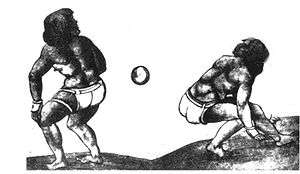Ulama (game)
.jpg)
Ulama ([uˈlama]) is a ball game played in a few communities in the Mexican state of Sinaloa. Descended from the Aztec version of the Mesoamerican ballgame,[1] the game is one of the oldest continuously played sports in the world and is notable for the fact that it is the oldest known game using a rubber ball.
History
The word ulama comes from the Nahuatl word ōllamaliztli [oːlːamaˈlistɬi] a combination of ōllamas [ˈoːlːama] (playing of a game with a ball) and ōllei [ˈoːlːi] (rubber). Ōllamaliztli was the Aztec name for the Mesoamerican ballgame, whose roots extended back to at least the 2nd millennium BC and evidence of which has been found in nearly all Mesoamerican cultures in an area extending from modern-day Mexico to El Salvador, and possibly in modern-day Arizona and New Mexico.[2] Archaeologists have uncovered rubber balls dating to at least 1600 BC,[3] ballgamer figures from at least 1200 BC, and nearly 1500 ancient ball courts.[2][4]
However, due to its religious and ritual aspects, Spanish Catholics suppressed the game soon after the Spanish conquest, leaving it to survive in areas such as Sinaloa, where Spanish influence was less pervasive.[5]
Ulama
Ulama games are played on a temporary courts called a tastei ([tas.te], from tlachtli [ˈt͡ɬat͡ʃt͡ɬi], the Nahuatl word meaning "ballcourt"). The bounds of these long narrow courts are made by drawing or chalking thick lines in the dirt. The courts are divided into opposing sides by a center line, called an analco. A ball that is allowed to cross the end line, the chichi or chivo, will result in a point for the opposing team. Points or rayas ("lines", so named for the tally marks used to keep score) are gained in play. The scoring system provides for resetting the score to zero in certain conditions, which can make for lengthy games.
The modern-day game has three main forms:
- Ulama de cadera or hip ulama. A hip ulama team consists of five or more players (but there could be as many as twelve) wearing loincloths, with leather hip pads for some protection against the heavy (3 kg, around 7 lb) rubber ball.
- Ulama de antebrazo or forearm ulama. Played on a smaller field, with teams of one to three players and a ball lighter than that of hip ulama, the games requires the players to return the ball using their wrapped forearm.[6] Women often play this game.
- Ulama de mazo or Ulama de palo, in which a heavy (6–7 kg or 13-15 lb) two-handed wooden paddle strikes a 500 g (1 lb) ball, usually with teams of three or four.[7]
The object of the game is to keep the ball in play and in bounds. Depending on the score — and the local variant of the rules — the ball is played either high or low. A team scores a point when a player of the opposing team hits the ball out of turn; misses the ball; knocks the ball out of bounds; touches the ball with their hands or some other body part aside from the hip; accidentally touches a teammate; lets the ball stop moving before it reaches the centre line or even if they fail to announce the score after they have scored a point.
The first team that scores eight points wins. If both teams end up having the same number of points after a turn, both sides begin again from zero. One record-setting game reportedly lasted for eight days, but most modern games are stopped after about two hours.

Ulama balls
See also Mesoamerican rubber balls
See also
Notes
- ↑ Leyenaar (2001) p. 123.
- 1 2 Fox, John. The ball : discovering the object of the game, 1st ed., New York : Harper, 2012. ISBN 978-0-06-188179-4. Cf. Chapter 4: "Sudden Death in the New World" about the Ulama game.
- ↑ See El Manati article for information on recovery of the earliest rubber balls.
- ↑ Taladoire counts 1560 courts discovered as of the year 2000, p. 98.
- ↑ Leyenaar (2001) p. 128.
- ↑ For a more indepth look at hip ulama and forearm ulama, see Leyenaar (2001).
- ↑ Federación Mexicana de Juegos y Deportes Autóctonos y Tradicionales, A.C.
References
- Federación Mexicana de Juegos y Deportes Autóctonos y Tradicionales, A.C. Ulama, accessed October 2007.
- Leyenaar, Ted (1978) Ulama, the Perpetuation in Mexico of the Pre-Spanish Ball Game Ullamaliztli. Leiden.
- Leyenaar, Ted (2001). ""The Modern Ballgames of Sinaloa: a Survival of the Aztec Ullamaliztli"". In E. Michael Whittington (Ed.). The Sport of Life and Death: The Mesoamerican Ballgame. New York: Thames & Hudson. pp. 97–115. ISBN 0-500-05108-9.
- Taladoire, Eric (2001). "The Architectural Background of the Pre-Hispanic Ballgame". In E. Michael Whittington. The Sport of Life and Death: The Mesoamerican Ballgame. New York: Thames & Hudson. pp. 97–115. ISBN 978-0-500-05108-5.
External links
| Wikimedia Commons has media related to Mesoamerican ballgame. |